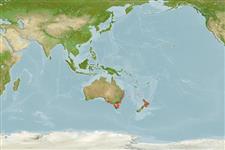Environment: milieu / climate zone / depth range / distribution range
Ecologia
marinhas; estuarina bentopelágico; intervalo de profundidade 0 - 20 m (Ref. 9002). Temperate; 25°S - 43°S, 135°E - 180°E
Western Pacific: southeastern Australia (southern Queensland to South Australia) and New Zealand.
Comprimento de primeira maturação / Tamanho / Peso / Idade
Maturity: Lm 29.5, range 22 - ? cm
Max length : 71.0 cm FL macho/indeterminado; (Ref. 6390); common length : 35.0 cm TL macho/indeterminado; (Ref. 2158); peso máx. publicado: 4.0 kg (Ref. 6390); idade máx. registrada: 24 anos (Ref. 95598)
Adults favor estuarine (including mangroves), rocky reef and inshore, coastal water habitats (Ref. 5962, 27248). They flourish in seagrass areas (Ref. 6390). Ludericks are moderately sedentary, schooling fish. They are herbivorous and feed primarily on seagrasses (Ref. 6390). Filamentous algae (Ref. 26966) and cabbage weed also form part of their diet (Ref. 28607). Marketed as fresh fish (Ref. 10384).
Maturing luderick form large aggregations. Mature fish undertake 'runs' from inside the rivers and coastal lakes to the sea. The fish spawn in the surf zone and estuary mouths (Ref. 6390).
Kailola, P.J., M.J. Williams, P.C. Stewart, R.E. Reichelt, A. McNee and C. Grieve, 1993. Australian fisheries resources. Bureau of Resource Sciences, Canberra, Australia. 422 p. (Ref. 6390)
Status na Lista Vermelha da UICN (Ref. 130435: Version 2024-1)
Ameaça para os humanos
Harmless
Uso pelos humanos
Pescarias: espécies comerciais; peixe esportivo: sim
Ferramentas
Relatórios especiais
Baixar XML
Fontes da internet
Estimates based on models
Preferred temperature (Ref.
123201): 14.6 - 23.6, mean 16.6 °C (based on 229 cells).
Índice de diversidade filogenética (Ref.
82804): PD
50 = 0.5000 [Uniqueness, from 0.5 = low to 2.0 = high].
Bayesian length-weight: a=0.01047 (0.00629 - 0.01744), b=3.03 (2.88 - 3.18), in cm total length, based on LWR estimates for this species & (Sub)family-body (Ref.
93245).
Nível Trófico (Ref.
69278): 2.1 ±0.1 se; based on diet studies.
Resiliência (Ref.
120179): Baixo, tempo mínimo de duplicação da população 4,5 - 14 anos (K=0.2; Fec=300,000; tmax=24).
Prior r = 0.25, 95% CL = 0.17 - 0.38, Based on 1 data-limited stock assessment.
Fishing Vulnerability (Ref.
59153): Moderate vulnerability (36 of 100).
Climate Vulnerability (Ref.
125649): Very high vulnerability (81 of 100).
Nutrients (Ref.
124155): Calcium = 26.6 [13.6, 47.1] mg/100g; Iron = 0.295 [0.151, 0.530] mg/100g; Protein = 17.6 [16.4, 18.8] %; Omega3 = 0.334 [0.164, 0.724] g/100g; Selenium = 13.4 [5.4, 31.7] μg/100g; VitaminA = 6.94 [1.71, 26.86] μg/100g; Zinc = 0.729 [0.487, 1.182] mg/100g (wet weight);
